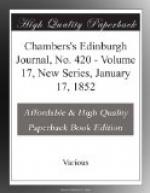There is another great change apparent here; albeit this has been a very gradual one. A stranger will have remarked with surprise that there are but few, very few, of the knee-breeched, top-booted, double-chinned, jolly, old-class farmers amongst the numerous groups who are either watching their sample-bags and waiting for customers, or chewing and smelling handfuls of wheat and barley, and casting what they do not swallow on the flags, already carpeted with grain. Still in addition to a strong sprinkling of ‘Friends,’ there are, he perceives, a goodly number of stalwart, handsomely-dressed individuals, many of them wearing kid gloves, and carrying silk umbrellas neatly ensconced in oil-skin cases. There is a group, one of whom has just refused 45s. per quarter for a sample of prime white wheat. If we approach nearer to them, we shall perhaps discover their quality. As I guessed! These gentlemen are distressed agriculturists, who prefer selling their own corn to sending it to any of the numerous highly-respectable salesmen who occupy the offices round the two markets. There are scores here of these well-attired, healthy-faced, hearty-looking, stout-limbed, but distressed individuals present, with not one of whom I should have the slightest objection to dine to-day, or on any other day, for that matter. But we must beware of rash judgments. Appearances are often deceitful, and we know, besides, from high authority, that grief is apt to puff up and swell a man sadly at times.
There is no possibility, an eminent salesman informed us, of making even a proximate guess at the quantity of business done; neither, it appears, is there any reliance to be placed upon the amount of ‘arrivals’ as given, either in the newspapers, or in the private circulars issued weekly to the trade. Corn, in this market, is usually sold at a month’s credit, with discount for cash. The buyer secures a sample of his purchase in a small canvas bag, and the seller is of course bound to deliver the quantity agreed for at the same weight and quality. There is one patent fact highly creditable to our British cultivators, which I gather from a trade-circular dated September 29, 1851, and this is, that foreign grains, wheats especially, do not command anything like such prices as the English varieties. The highest price of English white wheat is set down at 45s. per quarter; all foreign wheat is marked considerably lower: Russian is quoted at from 31s. to 33s.; whilst Egyptian and Turkish are marked from 24s. to 26s. per quarter; and fine American flour is quoted at a price considerably under ‘English Households.’ These are not signs of decrepit or faint-hearted farming.
Being so near, we may as well look in for a few moments at the New Coal Exchange opposite Billingsgate Market; a sightly, circular building, of rich interior decoration, that will well repay a visit. It is one of our newest ‘lions,’ and is certainly a very significant sign and monument of the enormous and swiftly-increasing commercial activity of the country. On the tesselated wooden floor—with the anchor in the centre, an emblem not long to be appropriate to such a place, as we shall presently see—thousands of tons of coal are disposed of with marvellous rapidity; the days of sale being the same as those of the Mark-Lane Market.




